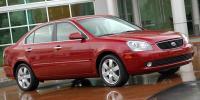Preview: 2006.5 Kia Optima
 |
By Carey Russ (c) 2006
SEE ALSO: New Car Buyer's Guide for Kia
Kia is not exactly the first name to spring to mind when thinking about cars, particularly cars of the ever-popular mid-size family sedan variety. The Korean-based manufacturer would like to change that, with its new 2006.5 Optima, which was recently introduced to the automotive press in California's Napa Valley and is now available.
Don't confuse the 2006.5 Optima with the 2006 Optima, the last iteration of a car introduced back in 2001. The new-generation Optima shares only the name, and the optional V6 engine. It's built on a new platform, with a longer wheelbase and increased width giving more interior space - more than any of the other common mid-size sedans, actually. The trunk is substantially larger, and like all new Kias, the full complement of safety equipment - six airbags, active front headrests, a tire pressure monitoring system, and four-wheel disc brakes - is included as standard equipment in all models. Antilock brakes with electronic stability control, traction control, and brake assist are available as a packaged option.
Most apparent is new and much more contemporary styling. Gone are the somewhat strange proportions of the first-generation Optima, replaced by a fuller and much more mainstream look, with short overhangs for optimum space utilization.
Inside, the increased space is readily apparent, as is very good fit and finish. Like the exterior, the interior styling is tastefully conservative. The seats proved comfortable enough for a long day's drive, and comfort was further improved by a low level of noise from all sources - road, wind, and the drivetrain.
Like its competitors, the new Optima is a front-wheel drive car available in four-cylinder or V6 trim. The V6 is the same 2.7-liter unit found in recent models of the first-generation Optima, but it now has 185 horsepower, a nearly ten percent improvement, and improved fuel economy. The 2.4-liter four is all-new, and with a fifteen percent power increase, to 161 hp, it bests most of its four-cylinder competitors. The four comes standard with a five-speed manual transmission, but is expected to be more likely sold with the optional five-speed automatic, which has a ``Sportmatic'' manual-shift mode and is the only transmission with the V6.
Suspension is fully-independent, with MacPherson struts in front and a multilink setup in the rear. It's tuned in a very European manner, softly sprung but well-damped, with spring, shock damping, and anti-roll bar rates all matched for a comfortable ride and good handling.
There are two trim levels for both drivetrains, LX and EX. Even the LX is well-equipped, with air conditioning, power windows and door locks, heated outside mirrors, a six-speaker AM/FM/CD audio system, and a split-folding rear seat standard fare. Specification of the automatic also adds cruise control, remote keyless entry, a tilt and telescope-adjustable instead of tilt-only steering column, and other interior enhancements. EX models get alloy wheels, foglamps, solar glass, an eight-way power-adjustable driver's seat, automatic temperature control, an upgraded Infinity audio system, and a number of interior conveniences.
The new Optima competes in a price-sensitive class, and with base prices ranging from $16,995 for a four-cylinder manual LX through $ 21,000 for an EX V6, it's very competitive.
For the mid-size sedans that are available with both four-cylinder and V6 engines, the fours are the best sellers. And, since Kia was touting its new four, when it came time to drive, I tried a couple of four-cylinder Optimas.
The first was a base model four-cylinder LX, with the manual transmission. Such cars are usually the most basic, bare-bones transportation appliances possible, with a negative fun-to-drive quotient. Suspensions are all too often characterized by the cheapest possible components, with minimal comfort and indifferent handling.
However, Kia is attempting to establish itself by building cars that are more exciting than the norm, and is doing this by careful attention to suspension tuning and steering feel. And Kia has been quite successful in its efforts. The "base model" Optima is no different from the more upscale versions, with the exception of wheel and tire sizes, and gave a ride quality that would be competitive with some cars costing well over $10,000 more. There is no rocket science involved, merely testing and attention to detail.
With the manual transmission, the four had plenty of power, and was an enjoyable drive on the roads through the hills around the Napa Valley. The four-wheel disc brakes gave it very good stopping power as well. At the halfway point, I traded the manual car for a four-cylinder LX automatic. And was pleasantly surprised. The five-speed automatic was a great match for the torquey four, with the standard manual shift mode really necessary only for entertainment purposes. With its good shift behavior, the automatic worked very well, even on the tightest roads.
The 2006.5 Kia Optima is a car with a distinctive character that offers an alternative to the common mid-size sedan.


